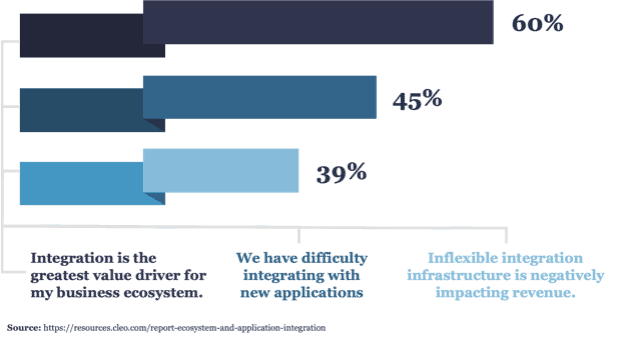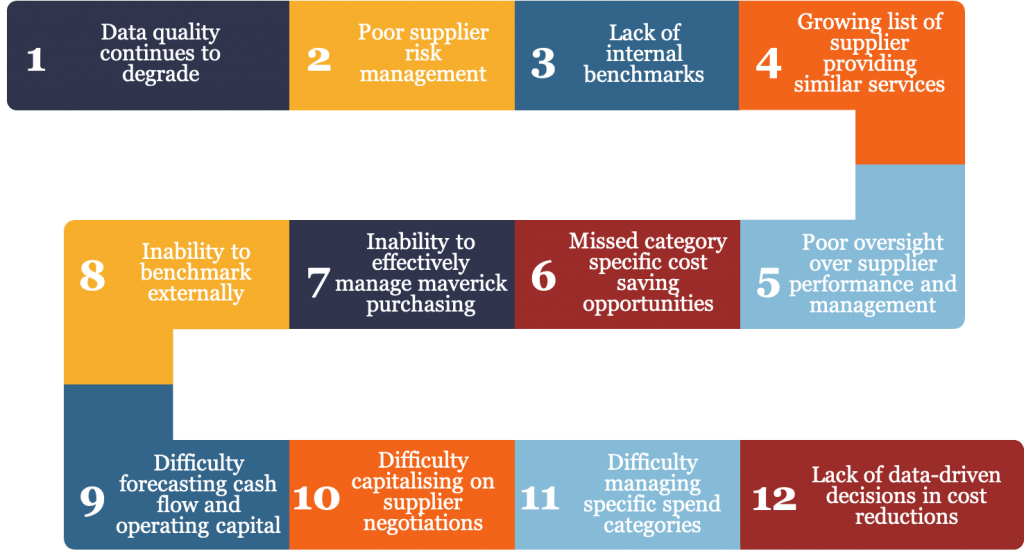Thought Leadership
How Can You Break Down Silos and Achieve Spend Visibility?
May 12, 2021


As a CFO or business leader, you have a big business decision that you need to make you and you need accurate spend data to help you make that decision, do any of the following scenarios sounds familiar to you?
- Your data is not available where it should be – its in multiple systems that don’t talk to each other
- You have duplicate data – in the same system as well as in when you try and combine data from the multiple system you have making the data unreliable
- You have conflicting data between systems – which one is the one source of truth?
- Your data is not in an accessible format – large spreadsheets, manual formulas and very little actionable insights.
- Your data is out of date – due to the sheer amount of manual work involved to pull the data together
If they do, it turns out you are not alone…
- 1 in 4 leaders are unsure how much the data they use is accurate (IBM)
- 92% of businesses are ware of duplicate data in their systems (Big Data Made Simple)
- Only 29% of businesses are currently integrated together (Mulesoft)
- 94% of businesses think data integration is a challenge (Jaggaer)
The Status Quo
Most companies today adopt a fragmented, siloed approach to analytics tools and data, which correlates with diminished business success.
The 26% of companies that use a single, common set of tools and methods across the business for accessing and analysing data exceeded their business goals last year by 80%. (Deloitte).
How and why did businesses get into this situation?
For most businesses, digital transformation is a constant journey, rather than a quick fix. Even for the most tech-savvy of companies, some information is likely still stored in a way that is inaccessible to some who could benefit from it. This might be because cloud apps are not adequately connected to each other, leaving business data spread across different islands in the cloud. It is also possible that some data is still stored on-premises in legacy databases or older apps.
Data management at an enterprise level has multiple challenges:
- Volume – too much and too challenging for organisations
- Variety – many types of data and sources
- Velocity – data is flowing into organisations quickly and requirements for speed in analytics are growing
- Veracity – there is a need for understanding the data that you can trust for financial reports, etc.
There isn’t a business in the world that planned to have multiple data platforms that are unable to talk to one another making any meaningful data analysis and real-time reporting almost impossible. Understandably, as businesses have grown and evolved new systems are utilised to support new business processes and models. Typically these decisions are made progressively and data integration can be an afterthought or not in scope.
Businesses are not ignorant to this, results from research from Cleo highlight business perspectives:

Data integration in principle, is not complicated. However there several challenges to getting these problems solved:
- IT backlog
Any IT department that isn’t overwhelmed with requests is in the minority. Given the typical IT backlog, many business users have to wait months or longer for a member of IT to review the work effort and then prioritise it.
- Stakeholder Management
The challenges with stakeholders are driven by two main areas to do with master data governance.
- A lack of ownership – most organisations admit that they don’t maintain good master data on suppliers. One of the main reasons is that ownership is not clear between procurement and finance. Typically the vendor master has a lot of garbage and no one wants to tackle the clean-up process.
- Lack of data governance – Even if ownership is clear, there is no governance around data and the purpose and use of data is not communicated therefore the data which is maintained is not fit for how the organisation would like to use the data
Data integration is supposed to make a business run more smoothly, but getting everyone to work together to get to that point can take some work.
- Cost and Resource availability
Implementing integrations, merging technology, and then rounding up the resources it would take to actually make it happen often seems out of reach for teams with limited budgets. More than half of IT leaders say their organisation struggles to find resources with integration skills, according to Forrester/Liaison Technologies.
- Complexity
As mentioned, integrations are in principle, straightforward. However, if not approached from a business process perspective and not solely a technical perspective a number of issues can arise. MuleSoft reported that in 2019 that while 97 percent of organisations are currently undertaking or planning to undertake digital transformation initiatives, integration challenges are hindering efforts for 84 percent of organisations, according to IT leaders. Integration projects have a poor track record of success as well, according to some studies as many as 70% of all system integration projects fail to achieve the goals set for the project.
- Disparate systems and processes
Take procurement and accounts payable as an example, large business units within the organisation have their own process and tools to manage these processes which makes data consolidation cumbersome. Sourcing, procurement, and accounts payable functions are usually run by different departments and these departments often optimise the process exclusively for their functions.
- “Not invented here” attitude
One of most common issues that arises regarding integration projects is the resistance of various internal stakeholders. The most typical one of these being from internal IT department. While the business should be the driver for an integration project, the IT department sometimes tends to forget their role as a support organisation, and it wants to act as the driver for the integration. This then easily leads into an argument by the IT department that “we can do this ourselves”.
Yet, as mentioned, IT departments typically do not have the required skill set to take on a complex, enterprise-wide data integration project. Typical IT department is also not very good at contacting third parties to engage in B2B integration. What typically tends to happen in these situations is that the organisation loses 6-12 months’ time before they realise that they cannot do the integration project by themselves.
How does this impact your business?
We’ve already covered in a previous post the challenges that organisations face without accurate control and visibility over their spend outlined in the image below:

What can businesses do to overcome this?
Fortunately, this is a problem that can be resolved, there are some very practical activities that organisations can undertake to try and get ahead of this.
The first thing to do is to come up with strategic plan for your data and the integrations that are required:
Define your Goals
You should have well-defined goals for data integration and these goals should be part of a wider business objective. For example, having a complete view of your spend could be a business goal. To achieve it, your integration plan should set a goal to integrate the all areas of your spend – direct, indirect, expenses and travel. Defining the goals will also give your IT team clues on which type of data should be integrated and which method to use.
Align your people
If you need to integrate your data, you’ll surely need an IT team. But next to those, who else do you need onboard? While one of the advantages of integration is expanding the amount of people with access to data, probably not everyone needs to actually handle that data.
A lot of employees have access to data they don’t need to perform their work. That’s why limiting access to data (and not to information) is as important as instructing the people working with data on how to do it properly. Map your data stakeholders focussing on who will interact with both the data and the information.
Data Management and Security
Security and data are inseparable. And when integration implies the ‘movement’ of personal data, especially commercially sensitive information it’s important to identify all the systems where you store sensitive data and how you will protect it during data integration as well as where the data will end up.
Building vs Buying
Though it might seem like the decision depends entirely on the IT team, the right method should already be considered during the planning stage. Using third-party integration software, consolidating data, or building in-house integrations are very different when it comes to budget and resources.
If you have developers with integration experience in your IT department, you can have them build a custom P2P integration in house, rather than buy a packaged solution. Building your own integration, however, typically means that you will also have to manage and maintain a codebase that isn’t central to your business and is difficult to change.
The goal of an integration project shouldn’t be just a technical solution that enables the various IT systems to exchange information between them.
When this is the case, what happens is that the solution design will lead to an excessive mapping exercise and the most complex integration framework that is very rigid and difficult to develop further in the future.
How can Valtatech help?
If this is all starting to sound far too complicated and out of reach, don’t worry – that’s where we can help. From aligning the right technology with people and processes to developing the integrations ourselves and managing them for your through our Integration-as-a-Service , we’ve got you covered. Contact us today to find out more!




